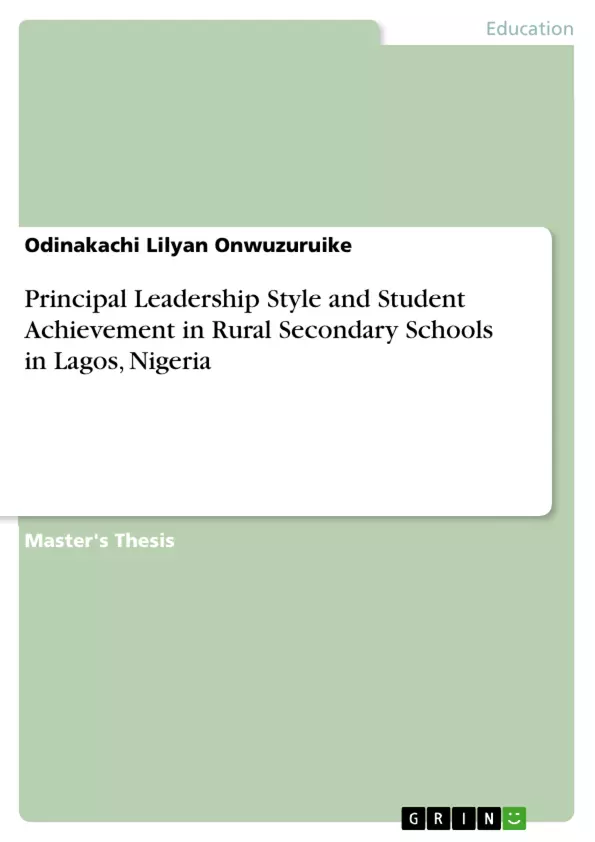The Leadership styles adopt by school principal plays an important role in raising the students' academic achievement in Nigeria. This study investigates whether the principal’s leadership styles influence student achievement in rural secondary schools in Nigeria. Firstly, the study determines the overall type of leadership style adopted by upper and lower rural secondary schools in Nigeria. Secondly, it establishes the principal leadership style behavior in both upper and lower secondary schools. Finally, the study intends to investigate the influence of the Nigerian principal leadership style on student achievement in upper and rural secondary schools.
The research design used is a quantitative descriptive sectional survey research design. The theoretical or educational gap, locational gap, and the approach gap were identified. In the research process, the researcher utilized two survey questionnaires, "Leadership Orientation Survey" from Bolman and Terrence E. Deal which has three sections, leadership styles, leaders' behavior, and overall rating respectively. The second survey contains one section “principal leadership survey”. Forty-six teachers in upper and forty in lower rural secondary schools were asked, but only 20 in upper and 20 in lower responded during the research. Frequency, percentage, and mean were used.
Inhaltsverzeichnis (Table of Contents)
- CHAPTER ONE: INTRODUCTION
- Background
- Statement of the problem
- Purpose of the study
- Objective of the study
- Research questions
- Significance of the study
- Scope of the study
- Limitation of the study
- CHAPTER TWO: LITERATURE REVIEW
- Introduction
- Definition of Terms
- Leadership
- Principal leadership
- Student performance
- Conceptual framework
- Leadership style
- School Leadership styles
- Leadership style and student achievement
- Influence of principal leadership style
- Principal leadership practice and behavior
- Principal Leadership and student performance
- Principal leadership style in Nigeria
- Research gap
- CHAPTER THREE: RESEARCH METHODOLOGY
- Geographical Area
- Research Design
- Data Sources
- Instruments
- Data Collection
- Data analysis
- Limitations
- CHAPTER FOUR: RESULTS OF THE STUDY
- Quantitative Findings
- Data collection tools and methods
- Variable measurement
- Presentation of data
- Demographic Descriptive Statistics
- Research Questions
- Leadership styles adopted by rural secondary school principals
- Principal leadership behaviour
- Principal leadership influence on student performance
- CHAPTER FIVE: DISCUSSIONS, FINDINGS AND RECOMMENDATIONS
- Discussion of Findings
- Leadership style adopted in URSSN and in LRSSN
- Principal leadership behavior
- Principal leadership style influencing student achievement
- Implications and relevant recommendation
Zielsetzung und Themenschwerpunkte (Objectives and Key Themes)
This study aims to examine the relationship between the principal's leadership style and student achievement in rural secondary schools in Nigeria. It investigates the prevalence of different leadership styles in these schools and analyzes the influence of these styles on student performance.
- The impact of principal leadership styles on student achievement in rural secondary schools in Nigeria
- The prevalence of different leadership styles in upper and lower rural secondary schools
- The connection between leadership styles and the academic performance of students
- The role of principal leadership behavior in fostering student achievement
- The differences in leadership styles and their impact on student performance in upper and lower rural secondary schools
Zusammenfassung der Kapitel (Chapter Summaries)
Chapter one introduces the background of the study, outlining the problem, purpose, objectives, research questions, significance, scope, and limitations of the research. Chapter two delves into the literature review, providing definitions of key terms, a conceptual framework, and an exploration of leadership styles, their influence on student achievement, and the specific context of principal leadership in Nigeria. Chapter three outlines the research methodology, including the geographical area, research design, data sources, instruments, data collection methods, and data analysis techniques. Chapter four presents the quantitative findings of the study, focusing on the data collection tools and methods, variable measurement, and the presentation of demographic and descriptive statistics. Chapter five discusses the findings, drawing conclusions about the leadership styles adopted in upper and lower rural secondary schools, principal leadership behavior, and the influence of leadership style on student achievement. The chapter also offers implications, recommendations, and suggestions for further study.
Schlüsselwörter (Keywords)
This study focuses on the crucial relationship between principal leadership style and student achievement in rural secondary schools in Nigeria. Key topics include: leadership styles (democratic, autocratic, laissez-faire), principal leadership behavior, student achievement, rural secondary schools, upper and lower rural secondary schools, and the Nigerian educational context.
- Arbeit zitieren
- Odinakachi Lilyan Onwuzuruike (Autor:in), 2023, Principal Leadership Style and Student Achievement in Rural Secondary Schools in Lagos, Nigeria, München, GRIN Verlag, https://www.grin.com/document/1321461



